If you’re looking to try the best food that Skopje has to offer, look no further!
This guide will take you on a culinary journey through the city, highlighting the most delicious and authentic dishes that you simply must try.
From succulent grilled meats to creamy desserts, there is something for everyone on this list.
Start planning your trip, and get ready to eat your way through Skopje!
Some of the must-try dishes in Skopje include:
- Burek
- Macedonian Sarma
- Moussaka
- Shopska Salata
- Turli Tava
- Traditional grilled meats
- Sheep’s milk cheese
- Kadaif
- Tavche Gravche
- Kebapi
- Baklava
- Skopsko (Beer)
- Turkish Coffee
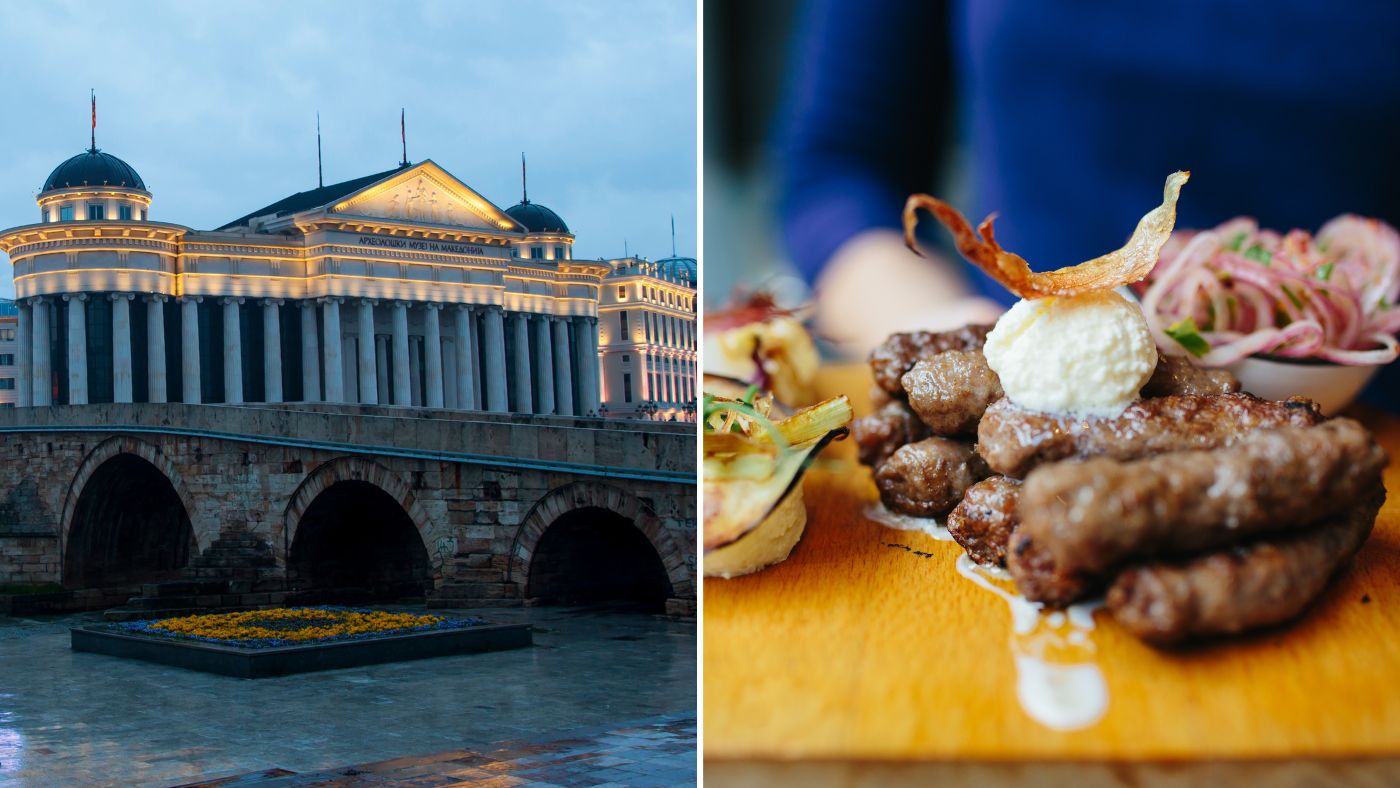
Burek:
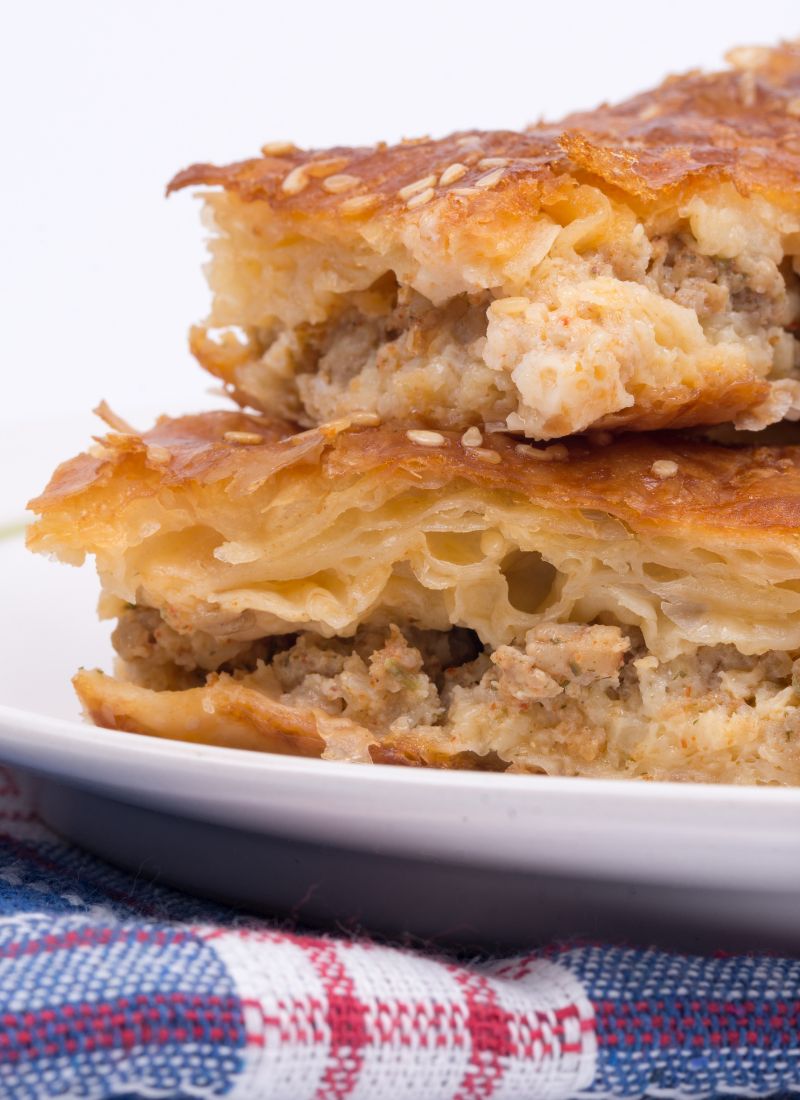
This traditional pastry is made by layering thin sheets of dough and fillings like minced meat and finely chopped onions or white cheese and spinach for those who prefer a vegetarian option.
The final product is then baked until golden brown and enjoyed, accompanied by a drink such as yogurt or boza, a traditional fermented beverage.
Burek is typically served for breakfast and is the perfect comfort food on a cold day.
The best Burek in Skppje be found in many bakeries, pastry shops, and even designated “burekdzilnica’s” (burek shops) throughout the city center and the Old Bazaar.
✅ The cheese and spinach Burek options are suitable for vegetarians.
Macedonian Sarma:
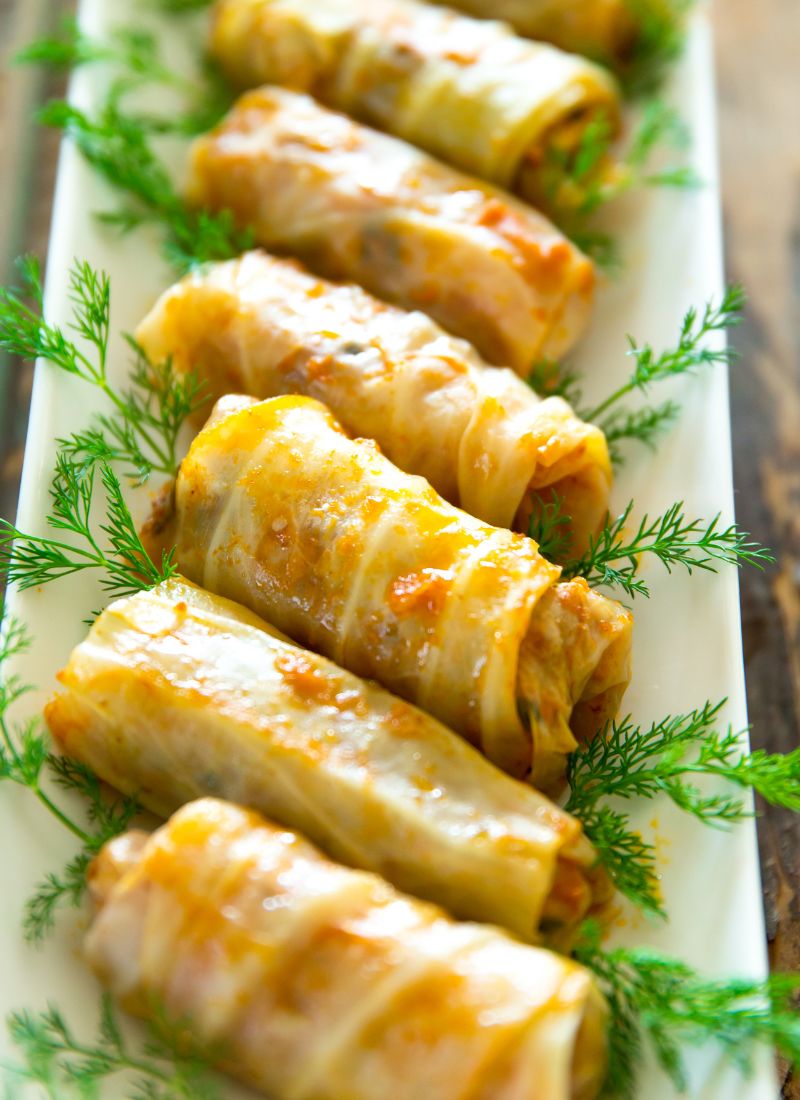
Originating from the Turkish word, which means ‘wrapped,’ Sarma is a dish popular in most Balkan countries, with each country having its own variation on how to make it.
Macedonian Sarma consists of cabbage rolls stuffed with flavorful fillings, including seasoned rice and can also contain ground meat, spices, and onions.
The cabbage leaves used in Sarma are usually pickled or fermented, giving the dish its unique tangy flavor.
This process also makes the leaves more pliable and easier to roll.
Prepared in larger quantities and served at gatherings and family meals during the colder months of the year, Sarma can easily be found all around Skopje, especially in kafana’s and traditional restaurants in the Old Bazaar.
✅ Macedonian Sarma can be suitable for vegetarians when filled with diced vegetables and rice.
Moussaka:
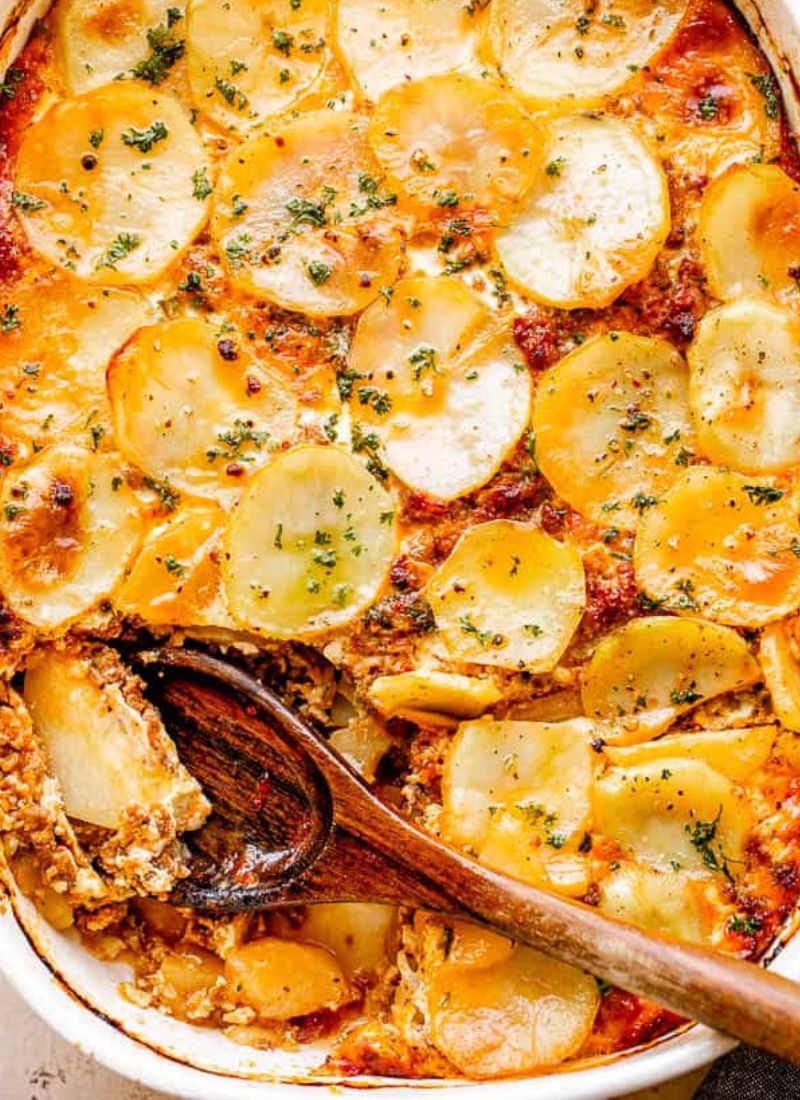
Moussaka is a dish popular in various forms across the Balkans, the Middle East, and Eastern Mediterranean.
The origins of moussaka are somewhat unclear, but it’s believed to have been introduced by the Arabs into the Mediterranean region, with the word “moussaka” possibly originating from Arabic.
The dish is traditionally based on either eggplant or potato, often including ground meat.
However, there are many local and regional variations, reflecting the dish’s widespread and long history.
Macedonian Moussaka is very similar to the Greek Moussaka and is made with layers of potatoes, minced meat (usually beef or lamb), onions, dried parsley, red pepper, black pepper, vegetable spice or salt, and a creamy sauce.
It’s both delicious and filling, making it the perfect meal for a winter’s day.
Macedonian Moussaka can also be enjoyed in many traditional restaurants or made at home due to the simple recipe.
❌ The traditional Macedonian recipe of the Moussaka is NOT for vegetarians.
Shopska Salata (Macedonian Salad):
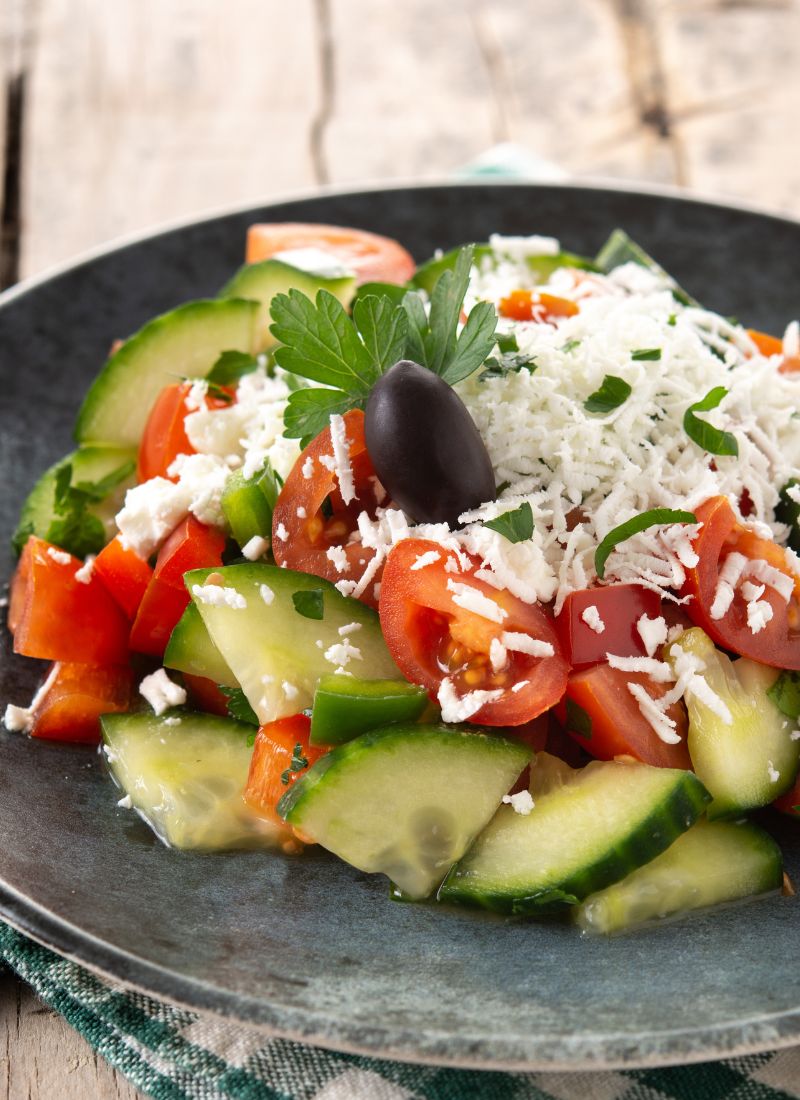
Shopska salata is a Bulgarian-style salad made with tomatoes, cucumbers, onions, and feta cheese.
It’s the perfect light and refreshing dish to balance out a heavier meal, but it can also be enjoyed as a diet-friendly main dish on a hot summer day and can be found in most restaurants throughout the city.
Some versions might include a garnish of olives or a sprinkle of chopped parsley, and dressing for the salad is typically a simple mix of olive oil and vinegar, though the vinegar is optional in some recipes.
It’s worth noting that Shopska salata is so loved in the region it has even won a European award for being the tastiest salad in Europe.
✅ This Shopska Salata is suitable for vegetarians.
Turli Tava:
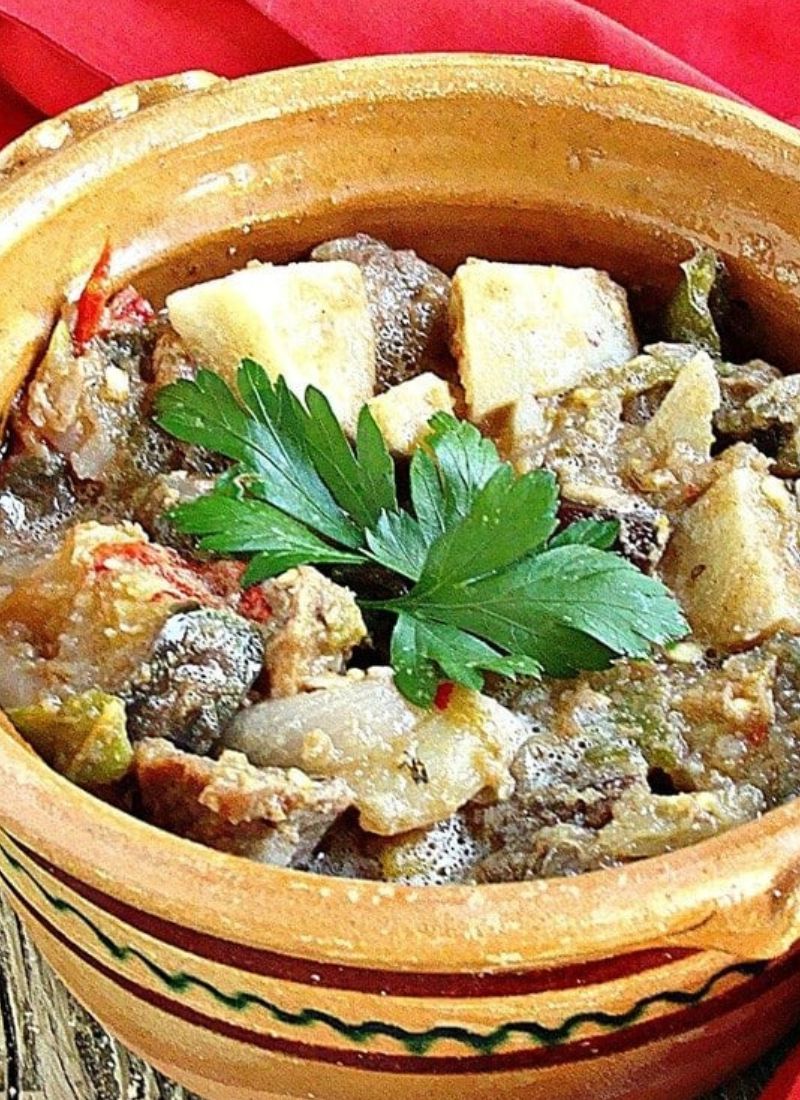
Turli Tava is a traditional Macedonian dish that is essentially a mixed vegetable stew, often with added meat.
It’s a favored dish due to its rich flavors and the flexibility it offers in terms of ingredients.
The name “Turli Tava” roughly translates to “mixed and baked,” which gives a pretty good idea of how this dish is prepared.
It’s typically made with various vegetables such as potatoes, eggplants, okra, carrots, peppers, onions, peas, and tomatoes. These are all mixed together in a pot or baking dish.
For those who include meat in their diet, chunks of beef or pork are often added to the mix.
The whole concoction is then seasoned with herbs and spices such as parsley, paprika, black pepper, and bay leaves. Some recipes also include rice.
Once everything is mixed together, it’s usually baked in the oven until all the ingredients are well-cooked and the flavors have melded together.
The result is a hearty, flavorful stew that’s often served with bread on the side.
But the best part about this dish is that it can be made as mild or spicy as you like, so don’t be afraid to ask for extra chili peppers if you’re feeling adventurous while dining out in Skopje.
✅ Turli Tava can be suitable for vegetarians.
Grilled meats:
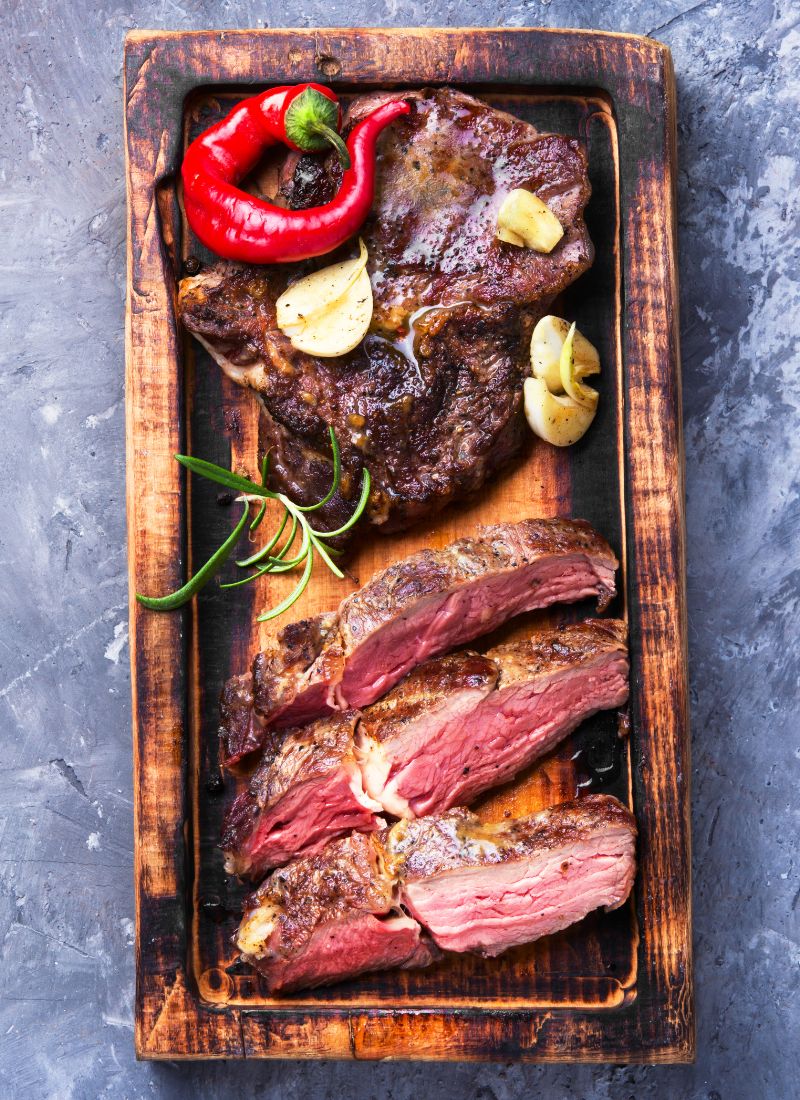
Skopje is home to some of the best grilled meats in the country!
Therefore, if you are a meat lover in Skopje, be sure to try pleskavica, a hearty, juicy patty made from minced meat and seasoned with garlic and other spices before being formed into large, flat patties and grilled to perfection, along with cevapi, which are small, finger-shaped sausages made from a similar mix and grilled to perfection.
These dishes are typically accompanied by freshly baked bread and a side salad, often the Shopska salata mentioned earlier, creating a balanced and satisfying meal.
The combination of the savory, spiced meats with the fresh, crisp salad and warm, fluffy bread makes for a truly delightful dining experience you must try when in Skopje.
❌ Obviously, this dish is NOT suitable for vegetarians.
Sheep’s milk cheese:
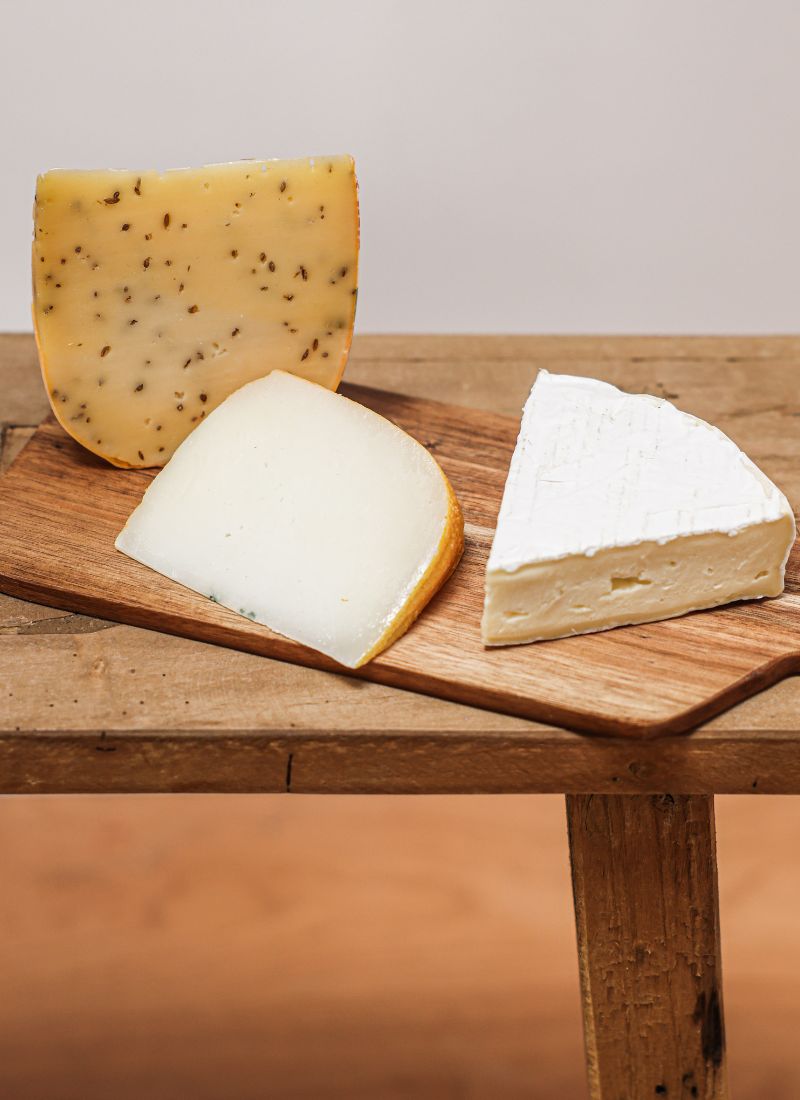
This traditional cheese is made from the milk of sheep that graze in the Macedonian mountains.
It has a strong and salty flavor and is often used as a topping on salads or grilled meats, but you can also find it served in a breaded form in many traditional restaurants, which is definitely worth trying.
If you’re looking for something truly unique, be sure to try the sheep’s milk cheese at one of Skopje’s many restaurants or by buying it in a market or directly from a farmer at the city’s Farmer’s Market.
✅ Sheep’s milk cheese is suitable for vegetarians.
Kadaif:
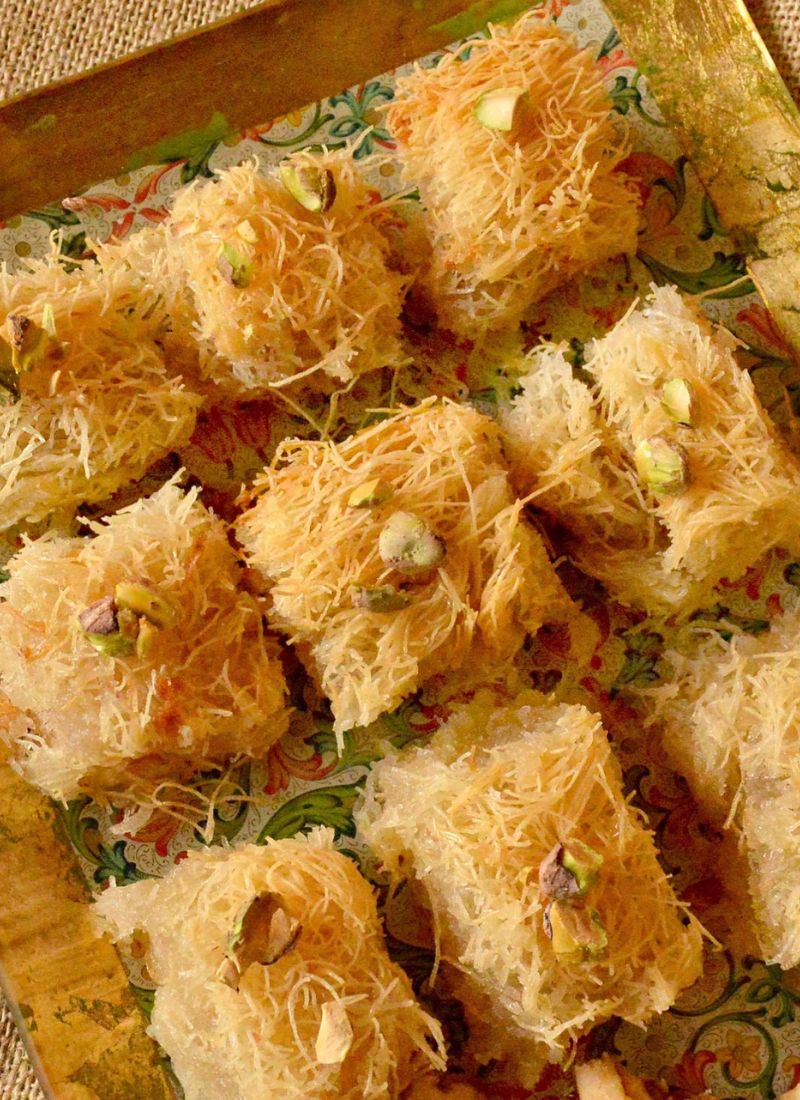
Kadaif is a popular dessert across the Balkans, Middle East, and the Mediterranean region.
It’s known by various names, such as kadayif, kataifi, and kunafeh, depending on the country.
In Skopje, kadaif is often made with shredded phyllo dough, which gives the dessert its characteristic stringy texture.
The dough is typically filled with shredded nuts, usually walnuts or pistachios, and sweetened with sugar, syrup, or honey.
Some variations may include a layer of soft cheese.
Once the kadaif is assembled, it’s baked until golden brown, then soaked in a sweet syrup, which could be flavored with lemon, rose water, or orange blossom water.
The result is a dessert that’s crunchy on the outside, soft and gooey on the inside, and delightfully sweet.
While in Skopje, you can find kadaif in many bakeries and dessert shops, where you can enjoy this tasty treat with ice cream, yogurt, or a strong Turkish coffee as a perfect way to end a meal.
✅ This traditional dessert is suitable for vegetarians.
Tavche Gravche:
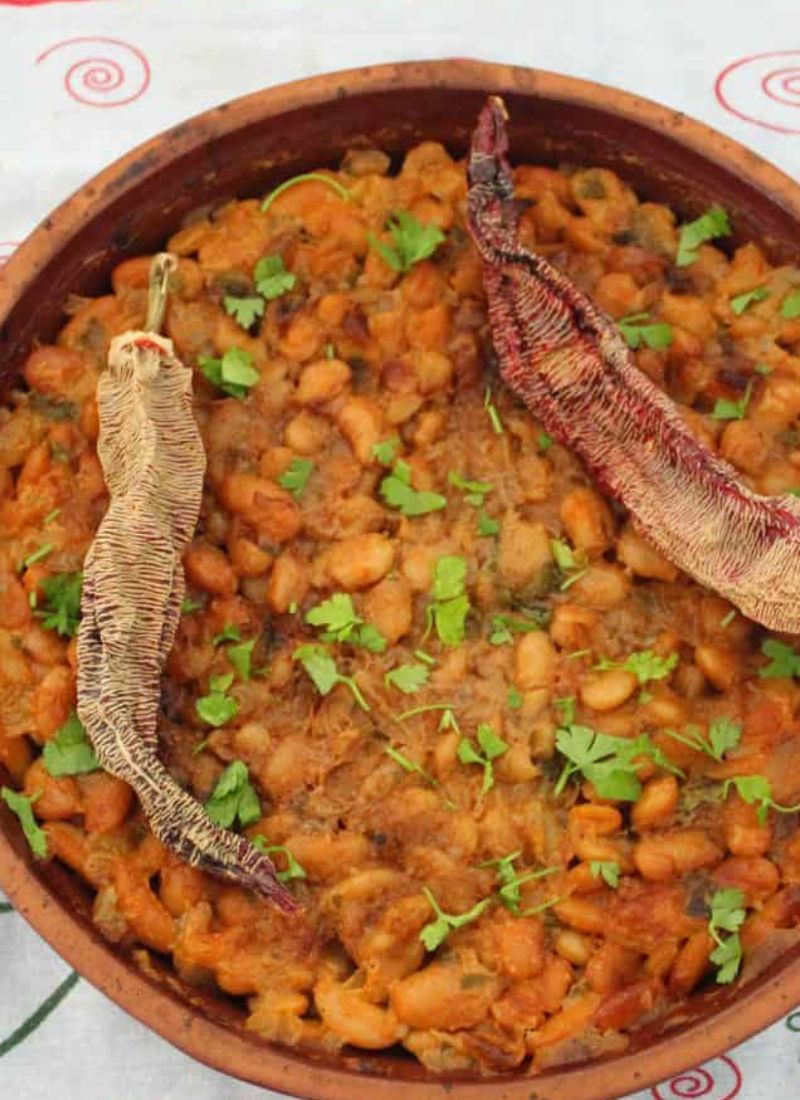
Tavche Gravche is the national dish of Macedonia, and as the country’s pride and joy, this hearty, comforting bean stew can be found in pretty much any restaurant that serves Macedonian food in Skopje.
The name “Tavche Gravche” translates to “beans in a pan,” which describes the method of cooking.
The dish is made with white beans that are soaked overnight and then boiled until tender.
After that, they’re mixed with onions, peppers, tomatoes, and various spices like paprika, then baked in a traditional clay pot called a “tavche.”
While Tavche Gravche is delicious on its own, it’s often served with sides like sausage, pickles, or salad, along with bread for dipping.
It’s a staple dish for family gatherings and special occasions, but it’s also a common everyday meal and is particularly popular with Orthodox Christians who fast on Fridays and abstain from meat, dairy products, and wine, and choose to enjoy this dish as it is primarily plant-based and fits within their dietary restrictions.
✅ The Tavche Gravche is suitable for vegetarians.
Kebapi:
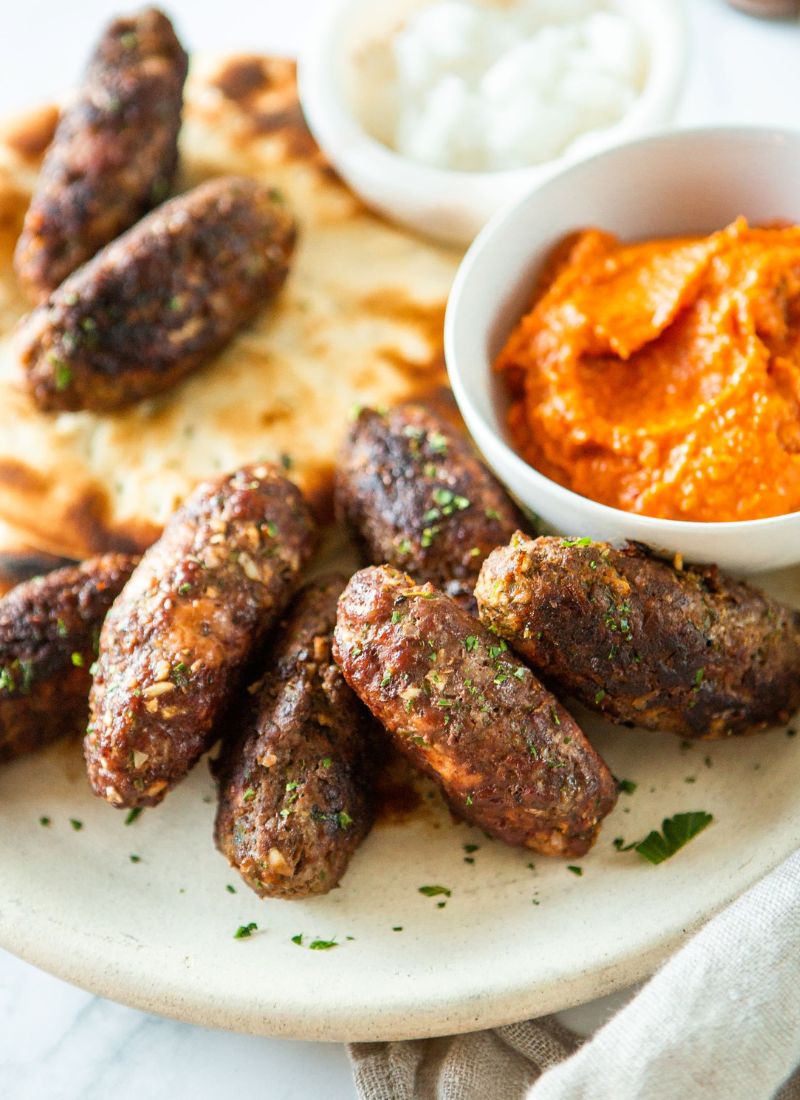
Also known as cevapi, Macedonian kebapi is a popular dish in the country as well as in most of the Balkan.
This dish is typically made with a mix of minced meats – often a combination of beef and lamb.
The meat is combined with spices like black pepper, garlic, and salt and then shaped into small, finger-sized sausages.
These are then grilled until they’re juicy and slightly charred.
In Skopje, kebapi is commonly served with warm bread on the side, often tucked inside to make a sort of sandwich.
It’s also frequently accompanied by chopped onions, sour cream, ajvar (a red pepper spread), and sometimes even smoked red pepper to add a spicy kick.
Kebapi can be found at many restaurants and street food stalls in Skopje as this dish is a beloved part of the local cuisine, enjoyed both as a quick snack and as a main meal.
Like Tavche Gravche, kebapi is a dish deeply tied to Macedonian culture and tradition.
It’s often served at celebrations and gatherings, but it’s also a common everyday meal.
❌ This dish is NOT suitable for vegetarians.
Baklava:
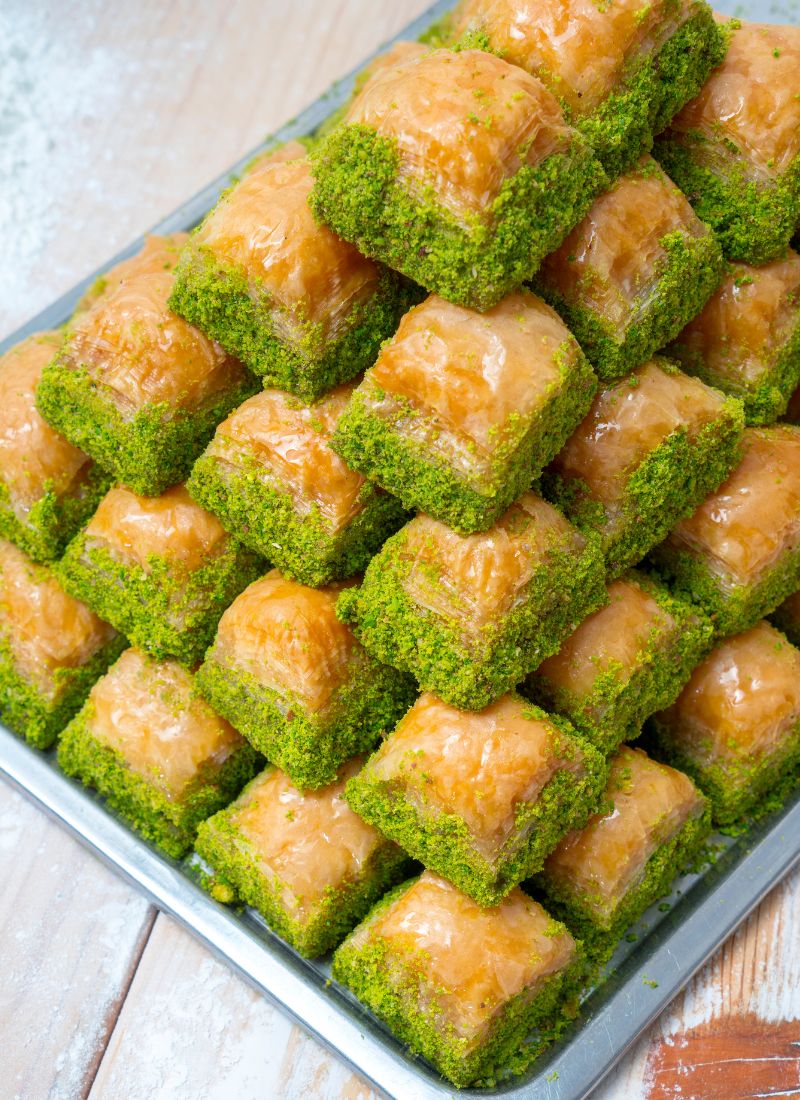
Baklava is a rich, sweet dessert pastry made of layers of phyllo filled with chopped nuts and sweetened and held together with syrup or honey.
Its history is not well-documented, as many ethnic groups have claimed it; however, the modern version of Baklava is often associated with the Ottoman Empire and was likely perfected in the palace kitchens in Istanbul.
From there, it spread to various parts of the empire, including Greece, Turkey, and the Middle East.
In the Balkans, Baklava is a popular dessert often made for special occasions like weddings, religious holidays, and family gatherings.
The process of making Baklava involves layering thin sheets of phyllo dough with a mixture of finely chopped nuts (often walnuts, pistachios, or almonds), sugar, and spices like cinnamon and cloves.
The layered pastry is then cut into pieces and baked until golden brown.
After baking, a sweet syrup made from sugar, water, and sometimes honey or lemon juice is poured over the hot pastry, allowing it to soak in and add to the sweetness.
Despite the rich history and various cultural claims to the dessert, Baklava is enjoyed by many around the world, including in Skopje, for its unique, rich flavor and satisfying texture.
A popular spot for finding a mouth-watering Baklava in Skopje is the Old Bazaar, where you can enjoy the tasty treat along with Turkish tea or coffee.
A fun fact about Baklava and Macedonia is that ethnic Albanians who live in the country and observe Ramadan would take the dessert to their neighbors as an invitation to celebrate the end of their religious holiday for that year.
This is a beautiful way for the two cultures and ethnicities to show respect toward one another.
✅ The Baklava deserved is considered suitable for vegetarians.
Skopsko:
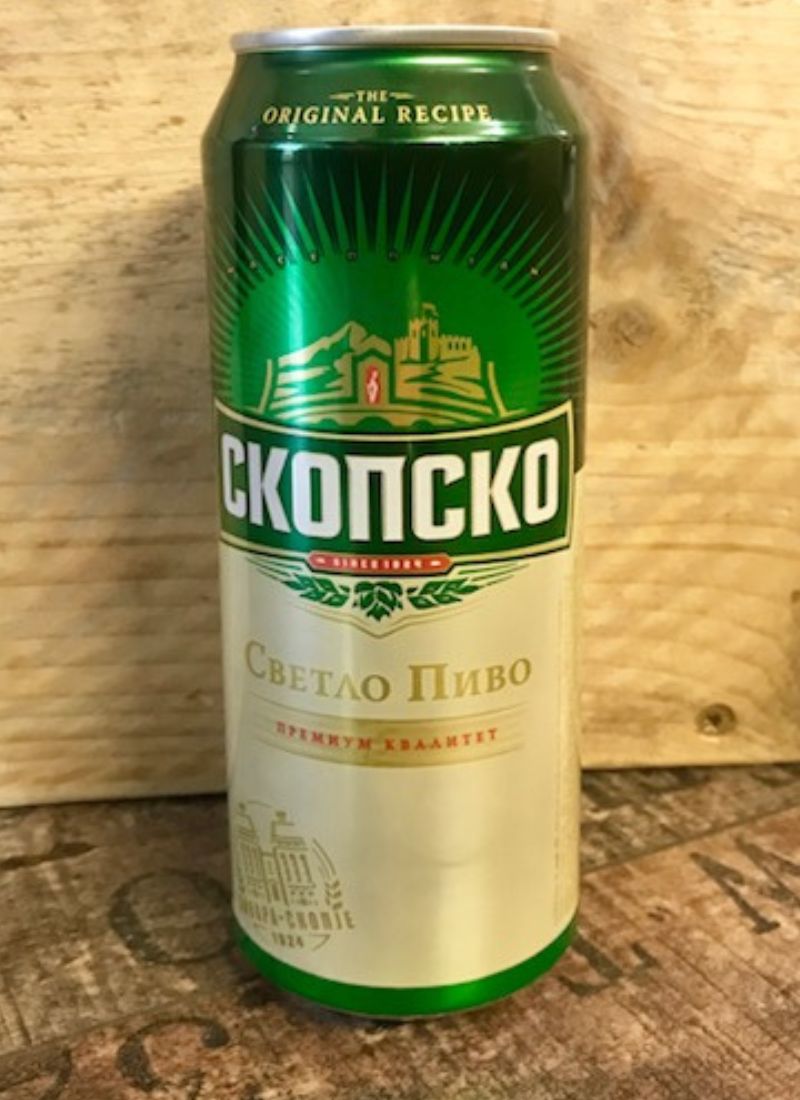
Macedonia’s national Skopsko beer (which you can get for less than $2) perfectly complements the above-mentioned dishes and can also serve as a refreshing treat after a hot summer day exploring Skopje’s many attractions.
Highly popular in Macedonia, holding nearly 70% of the national beer market, Skopsko is brewed by Skopska Pivara, which is a part of the Heineken Group and is of the German Pilsner style.
This type of beer is known for its clear, golden color, crisp flavor, and light to medium body.
The beer is a pale lager with a 4.9% alcohol volume, and its ingredients include water, barley malt, and hops.
Skopsko is available in different sizes, including 0.5L cans and 0.33L glass bottles, and comes in several different flavors: Skopsko Smooth, a lager beer with smooth, refined, and refreshing flavor, Skopsko Dark, which is a dark lager with a heavier taste profile, and Skopsko Radler, which is a lemon-flavored beverage for a tangy twist.
✅ Skopsko beer is suitable for vegetarians.
Turkish Coffee:
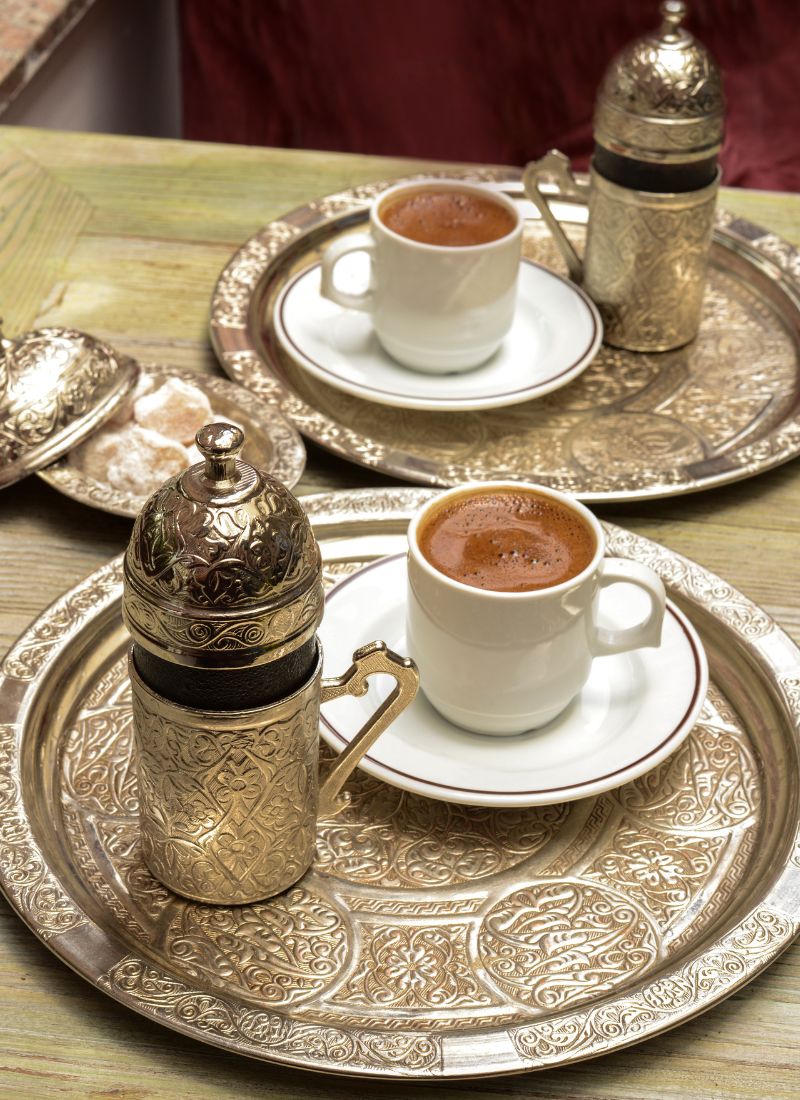
Skopje is known for its strong and flavourful Turkish coffee, which is made by boiling finely ground coffee beans in a pot (known as a cezve), with sugar according to taste, and served in a small cup where the grounds are allowed to settle.
This rich beverage is often enjoyed first thing in the morning or after a meal and can be found in most cafés throughout the city.
However, the high caffeine content coupled with the robust flavor can lead to increased stomach acid production, which in turn can cause heartburn, particularly in those who aren’t used to consuming such potent brews or if consumed on an empty stomach (by some.)
Therefore, if it’s your first time trying Turkish coffee, it’s advisable to consume it after a meal when your stomach is better equipped to handle its intensity.
Moreover, Turkish coffee is traditionally enjoyed slowly, allowing you to savor every sip and giving your body more time to process the caffeine.
✅ Turkish coffee is considered suitable for vegetarians.
https://www.youtube.com/watch?v=x-S3mGgu4Zg
What is The Macedonian Diet Based On?
Besides the cultural influences and long history of occupiers (which obviously influenced the traditional Macedonian diet), the Macedonian diet is based on the produce that is available in the country.
This means that the diet consists mostly of fruits, vegetables, and meats.
The climate in Macedonia is perfect for growing a variety of crops, so the country has access to a wide variety of fresh produce.
This bounty of fresh food forms the basis of the Macedonian diet, which is why you’ll find plenty of healthy and delicious options to choose from when dining in Skopje.
Is Eating Out Expensive in Skopje?
No, eating out in Skopje is not expensive. In fact, you can find plenty of affordable and tasty options throughout the city.
From street food that typically costs $3-5 to sit-down restaurants where a meal for two costs between $20-50, there’s something to suit every budget in Skopje.
So whether you’re looking for a quick bite or a leisurely meal, you’ll be able to find it without breaking the bank.
Will You Find Vegan & Vegetarian Options in Skopje?
Yes, there are plenty of vegan and vegetarian options available in Skopje.
With the abundance of fresh produce that is available in the city, it’s easy to find dishes that are both healthy and delicious.
So whether you’re looking for a light salad on a hot summer day or a vegetable stew to warm you up during a cold winter day, you’re sure to find something to your liking.
Skopje is a city with a rich history and culture, which is reflected in its cuisine.
There are many different dishes to try while you’re in the city, so whether you’re looking for something light and refreshing or hearty and filling, you’re sure to find it.
I hope this list has given you some ideas of the best food to try while you’re in Skopje.
This guide was first published on July 19, 2022 and was last updated on August 18, 2025. For more information, please contact us at contact@skopjeguide.com.